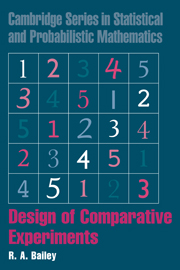Book contents
- Frontmatter
- Contents
- Preface
- 1 Forward look
- 2 Unstructured experiments
- 3 Simple treatment structure
- 4 Blocking
- 5 Factorial treatment structure
- 6 Row–column designs
- 7 Experiments on people and animals
- 8 Small units inside large units
- 9 More about Latin squares
- 10 The calculus of factors
- 11 Incomplete-block designs
- 12 Factorial designs in incomplete blocks
- 13 Fractional factorial designs
- 14 Backward look
- Exercises
- Sources of examples, questions and exercises
- Further reading
- References
- Index
4 - Blocking
Published online by Cambridge University Press: 30 October 2009
- Frontmatter
- Contents
- Preface
- 1 Forward look
- 2 Unstructured experiments
- 3 Simple treatment structure
- 4 Blocking
- 5 Factorial treatment structure
- 6 Row–column designs
- 7 Experiments on people and animals
- 8 Small units inside large units
- 9 More about Latin squares
- 10 The calculus of factors
- 11 Incomplete-block designs
- 12 Factorial designs in incomplete blocks
- 13 Fractional factorial designs
- 14 Backward look
- Exercises
- Sources of examples, questions and exercises
- Further reading
- References
- Index
Summary
Types of block
If the plots are not all reasonably similar, we should group them together into blocks in such a way that plots within each block are alike.
There are three main types of block.
Natural discrete divisions
These divisions between the experimental units are already present. If the experimental units are new-born animals then litters make natural blocks. In an experiment on people or animals, the two sexes make obvious blocks. In testing tags on cows' ears, the ears are the experimental units and cows are the blocks. In an industrial process, a block could be a batch of chemical or ore used for part of the process.
Example (Insect repellent) Midges in Scotland are a severe irritant in July and August. A researcher wants to try out some insect repellents, which are applied to people's skin. Twelve people volunteer for the experiment. It is known that people vary widely in their attractiveness to midges, so the researcher uses people as blocks, applying different repellents to each arm. After a fixed period of exposure to midges, the number of midge bites on each arm of each volunteer is recorded.
Sometimes there is more than one type of natural discrete block. If the experimental units are half-leaves of tobacco plants then whole leaves make one sort of block while the plants make another. In a consumer experiment, such as Example 1.11, testers and weeks are both natural blocks. In an experiment in the laboratory, technicians, benches and days may all be blocks.
If an experiment is carried out on plots that had previously been used for another experiment then you should consider whether to deem the previous treatments to be blocks.
- Type
- Chapter
- Information
- Design of Comparative Experiments , pp. 53 - 74Publisher: Cambridge University PressPrint publication year: 2008
- 1
- Cited by



